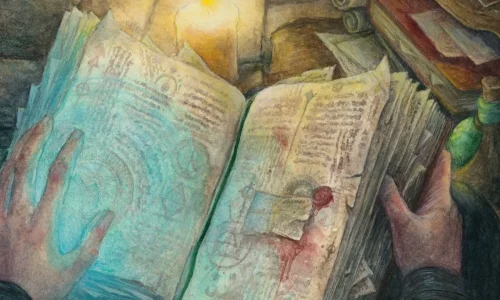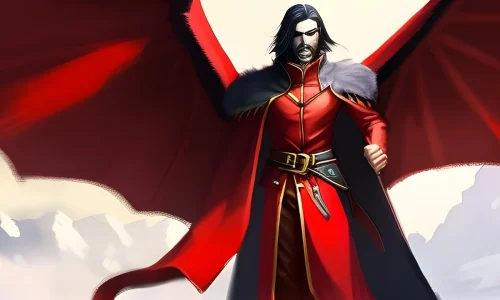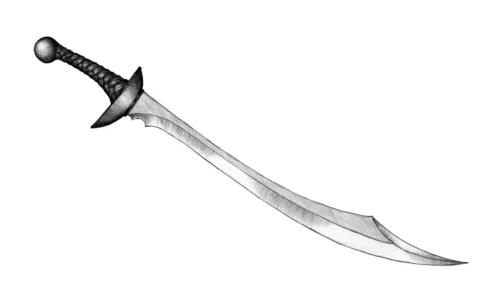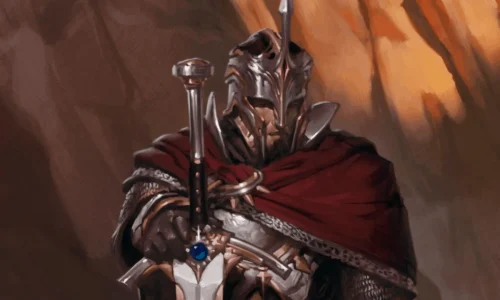The 5e shifter is a playable race that can transform parts of its body into a more animalistic form, granting them temporary enhancements to its physical abilities in Dungeons and Dragons (DnD).
They are typically humanoid in appearance but can take on aspects of various animals such as claws, enhanced senses, and a thick hide. Shifters are known for their adaptability and connection to nature, often living as nomads and valuing self-sufficiency and independence.
Benefits of Playing a 5e Shifter Character
Below are a few of playing a shifter character benefits in D&D 5e
Combat Versatility:
Shifters are versatile and adaptable in combat, making them excellent battle opponents. Their ability to transform parts of their body into an animalistic form grants them temporary physical enhancements such as increased speed, strength, or defense.
This makes them formidable in combat scenarios where they can adapt to various situations.
Enhanced Senses:
Shifters have heightened senses and natural tracking abilities, which makes them ideal for exploration and investigation scenarios. Their ability to track prey or locate hidden objects is valuable to any adventuring party.
Roleplaying Opportunities:
Moreover, Shifters’ enhanced senses and physical abilities make them well-suited for combat and exploration. They can adapt to various situations by using their shape-shifting abilities to gain a tactical advantage. As a player character, choosing to play as a Shifter can provide a dynamic and exciting gameplay experience.
Cultural Background:
The Shifter race offers a range of benefits for character development, with their nomadic lifestyle and connection to nature. Playing a Shifter character can provide an exciting gameplay experience with their combat versatility, enhanced senses, and rich cultural background.
Shifter Traits and Abilities
In Dungeons and Dragons 5th edition, Shifters are a playable race with unique traits and abilities. Some of their notable features include:
- Ability Score Increase: Shifters gain a +2 bonus to their Dexterity score and a +1 bonus to either their Wisdom or Constitution score.
- Dark vision: Shifters have a dark vision, allowing them to see in dim light within 60 feet as if it were bright light.
- Shifting: As a bonus action, Shifters can choose to shift their body to gain temporary physical enhancements. Depending on their subrace, they can choose to shift into different forms, granting them different benefits. Shifting lasts for 1 minute or until the Shifter chooses to end it.
- Shape-shifting: Shifters can change their physical appearance or form, often into that of an animal or mythical creature.
- Enhanced senses: Many shifters have heightened senses, such as improved hearing, smell, and vision.
- Superhuman strength and speed: Shifters often possess physical abilities that exceed those of humans, including enhanced strength, speed, and agility.
- Healing abilities: Some shifters have regenerative abilities, allowing them to heal quickly from injuries.
- Resistance to injury: Shifters may also have increased durability, making them resistant to damage that would harm a normal human.
- Animalistic behavior: Depending on the lore, shifters may display animalistic behavior, such as hunting instincts or territorial behavior.
- Transformation triggers: Shifters may require a trigger to transform, such as the full moon, intense emotions, or conscious control over their transformation
Shifting Mechanics and Limitations
There are a few mechanics and limitations to keep in mind regarding shape-shifting abilities, depending on the specific class or race:
A Limited Number of Uses
Some classes or races, such as druids or changelings, can shape-shift, but they may have a limited number of uses per day or rest.
Transformation Time
The time it takes to shift forms may vary, depending on the class or race. For example, a druid can use their Wild Shape ability as a bonus action, while a werewolf from a homebrewed race may require an action to transform.
Limited Forms
Depending on the class or race, shapeshifters may be limited to specific forms. For example, a druid can only shift into a creature they have seen before, while a werewolf may only have access to their wolf form.
Limited Duration
The duration of a shapeshift may also vary depending on the class or race. For example, a druid’s Wild Shape lasts for several hours equal to half their druid level, while a werewolf may only be able to maintain their wolf form for a certain number of rounds.
Reverting to the Original Form
In some cases, shape-shifters may revert to their original form if they take damage while in their shifted form or if they use up the duration of their ability.
No Equipment
When a character shape-shifts, their equipment does not transform with them. This means that any equipment they were carrying before the transformation will fall to the ground.
Specific Abilities
Depending on the specific shape-shifting ability, there may be specific rules or limitations to how certain abilities work in the shifted form. For example, a druid’s Wild Shape ability specifically states that they cannot cast spells while in animal form.
Size Restrictions
Some shape-shifting abilities may be restricted by the size of the creature being transformed into. For example, a druid’s Wild Shape can only be used to transform into creatures with a challenge rating equal to or less than their level, and the size of the transformed creature cannot exceed Medium.
Concentration
Some shape-shifting abilities may require concentration, meaning that the character cannot use other abilities or cast spells while maintaining the shifted form.
Damage Resistance or Vulnerability
Depending on the shifted form, the character may gain resistance or vulnerability to certain types of damage.
Perception and Communication
When in a shifted form, a character may have different perceptions and abilities to communicate, such as gaining the ability to speak with animals or losing the ability to communicate in their original language.
Classes that Synergize Well with Shifter Abilities
Some classes in Dungeons and Dragons 5th edition synergize well with the abilities of the Shifter race. Some of these classes include:
Barbarian: Barbarians excel in close combat and can benefit greatly from the Shifter’s enhanced physical abilities while shifted. The Beasthide subrace can provide additional durability, making them even more effective as front-line fighters.
Ranger: Rangers are skilled trackers and explorers, making them a good fit for the Shifter’s enhanced senses and natural tracking abilities. The Swiftstride subrace can also provide additional mobility, making it easier for Rangers to move quickly through the terrain.
Rogue: Rogues rely on their agility and finesse to outmaneuver opponents, making the Shifter’s enhanced speed and mobility a valuable asset. The Longtooth subrace can provide additional damage, making them more deadly in combat.
Class Abilities that Enhance Shifter Traits
Certain class abilities in D&D 5e can enhance the traits and abilities of a Shifter character. Some examples include:
- Druid: Druids can use their Wild Shape ability to transform into animals, which can complement the Shifter’s transformation abilities. This can provide even more versatility and adaptability in combat and exploration scenarios.
- Fighter: Fighters have access to many combat-focused abilities, which can be enhanced by the Shifter’s physical enhancements. Certain Fighter subclasses, such as the Battle Master, can also use their maneuvers to further increase their combat effectiveness.
- Monk: Monks rely on their agility and unarmed strikes in combat, making the Shifter’s enhanced physical abilities a valuable asset. Additionally, certain Monk subclasses, such as the Way of the Beast, have abilities that synergize well with the Shifter’s transformation abilities.
A shifter character can be a valuable addition to any adventuring party in D&D 5e. With the right class synergies and abilities, they can become a powerful and versatile combatant, skilled trackers, and adept explorer.
Famous Shifter Sub-Races
5e Shifter subraces are a unique feature of the race in Dungeons and Dragons. These subraces give players the ability to customize their Shifter character by granting them additional abilities and enhancing existing ones.
Each subrace is tied to a specific type of animal, providing players with a range of options to choose from. The following are brief introductions to each Shifter subrace:
Beasthide
Beast hide Shifters have a tough, animalistic hide that provides natural armor, giving them an AC of 11 + their Dexterity modifier (to a maximum of +2).
This ability allows Beasthide Shifters to wade into battle without the need for heavy armor, making them ideal for melee combat. They also gain proficiency in the Athletics skill, allowing them to climb and swim with ease.
Cliffwalk
Cliff walk Shifters can climb walls and other surfaces as if they had a climb speed equal to their movement speed. This ability makes them incredibly versatile in both combat and exploration, as they can easily navigate difficult terrain.
They also gain proficiency in Acrobatics skill, allowing them to move with ease across precarious surfaces.
Longtooth
Long tooth Shifters have powerful jaws that allow them to make a bite attack as a bonus action. This attack deals piercing damage equal to 1d6 + their Strength modifier. They also gain proficiency in the Intimidation skill, reflecting their fierce, predatory nature.
Swiftstride
Swift stride Shifters have incredible speed, increasing their base walking speed by 5 feet. This ability allows them to keep up with faster party members and easily escape danger. They also gain proficiency in the Stealth skill, reflecting their ability to move quietly and swiftly.
Swiftwing
Swift wing Shifters have wings that allow them to fly for short periods. They can use this ability once per short or long rest and can fly for several minutes equal to their Constitution modifier (minimum of 1 minute). They also gain proficiency in the Perception skill, reflecting their sharp senses and keen eyesight.
Wild Hunt
Wild hunt Shifters can track prey with incredible accuracy, gaining an advantage on Wisdom (Survival) checks made to track creatures. This ability makes them ideal for hunting and tracking down enemies. They also gain proficiency in the Survival skill, allowing them to survive in even the harshest wilderness environments.
Advantages and Disadvantages 5e Shifter
| Advantages | Disadvantages |
|---|---|
| Shifting abilities provide unique combat and exploration options. | Limited customization options compared to other races. |
| Access to powerful subrace traits, such as enhanced speed or natural weapons. | Shifting abilities have limitations and require careful management to avoid exhaustion. |
| Interesting role-playing opportunities, with potential conflicts between human and animal instincts. | May be subject to social stigmas and prejudice within the game world. |
| Built-in backstory and cultural ties to the world of Eberron. | It may require additional explanation or backstory for groups unfamiliar with Eberron lore. |
| Can fit well thematically with classes such as Druid or Ranger. | May not fit well thematically with certain classes or playstyles. |
Effective Use of Shifting
Shifters have unique abilities related to their ability to shift into a more bestial form. Effective use of shifting in combat and exploration can greatly enhance a Shifter’s ability to succeed in these situations.
For example, a Beasthide Shifter can use its Shifting ability to gain temporary hit points and increased damage resistance, making them a formidable tank in combat.
A Swiftstride Shifter can use their Shifting ability to gain increased speed and mobility, making them ideal for scouting and exploration. By strategically using their shifting abilities, Shifters can maximize their effectiveness in a variety of situations.
Role-playing Opportunities
Playing a Shifter character in Dungeons and Dragons 5th edition offers a range of role-playing opportunities and potential character development. The Shifter’s animalistic nature can create interesting dynamics in social interactions and character relationships.
For example, a Shifter who embraces their bestial side may struggle to control their instincts and impulses, leading to impulsive or reckless behavior. On the other hand, a Shifter who resists their animalistic urges may struggle with feelings of repression or internal conflict.
Additionally, a Shifter’s subrace can also play a role in their character development. For example, a Longtooth Shifter who has experienced discrimination or ridicule for their appearance may feel a sense of pride in their predatory traits and use them to intimidate others.
Similarly, a Swiftstride Shifter who has spent their life on the run or in hiding may struggle with feelings of restlessness or a desire for freedom.
Exploring these character traits and motivations can create engaging and dynamic role-playing experiences, allowing players to fully immerse themselves in their Shifter character and create a unique and memorable story.
Ability Score Allocation and Optimization
The ability scores of a Shifter character are a crucial aspect to consider while optimizing the character. Depending on the subrace and the desired role, players should prioritize certain ability scores over others.
For example, a Beasthide Shifter tank may need to have high Constitution and Strength scores, while a Swiftstride Shifter scout may benefit from high Dexterity and Wisdom scores. By allocating ability scores strategically, players can maximize their Shifter’s potential and create a more effective character.
Choosing the Right Skills and Backgrounds
When choosing skills and backgrounds, players should consider how their Shifter’s abilities can complement their chosen proficiencies. For instance, a Beast hide Shifter proficient in Athletics and with a soldier background may excel at physically demanding tasks like climbing, jumping, and carrying heavy objects.
By selecting skills and backgrounds that complement their Shifter’s abilities, players can create a more well-rounded and effective character.
Feats and Multiclassing Options
It is an additional option that can enhance a Shifter character’s abilities. Feats like Mobile or Alert can complement the Swift stride Shifter’s mobility and perception, while feats like Savage Attacker or Dual Wielder can increase the damage output of Long tooth Shifters in combat.
Multiclassing into another class can also be a viable option to gain access to additional abilities and increase the character’s versatility. By considering feats and multiclassing options, players can create a more diverse and adaptable Shifter character.
Build and Back-Story Idea
Building a shifter character in Dungeons and Dragons can be a fun and rewarding experience. Here are some character-build and backstory ideas to inspire you:
Werewolf Barbarian
Create a character who is a ferocious werewolf who channels their primal rage into their barbarian abilities. Their backstory could involve a tragic incident that caused them to lose control of their shifter abilities and wreak havoc on their community. They may now seek redemption by using their strength to protect those they once harmed.
Changeling Rogue
Build a shifty changeling character who uses their shape-shifting abilities to infiltrate and manipulate their targets as a rogue. Their backstory could involve a life of deception and thievery, and they may have a secret agenda that they are working towards while disguising themselves as someone else.
Druid of the Circle of the Moon
Play as a druid who focuses on their shape-shifting abilities as a member of the Circle of the Moon. Their backstory could involve a connection to the natural world and a desire to protect it at all costs. They may have a deep respect for the animals they transform into and see them as equals.
Werebear Paladin
Create a character who is a noble werebear who has taken up the mantle of a paladin to protect their community. Their backstory could involve a transformation that allowed them to gain insight into the darkness of the world, and they now use their abilities to bring light and justice to those in need.
Shifter Ranger
Build a character who is a skilled hunter and tracker, using their shape-shifting abilities to gain an edge in combat. Their backstory could involve a life spent living off the land and defending their territory from threats. They may have a close bond with the animals they transform into and see them as trusted companions.
Half-Elf Shifter Druid
Shifter Warlock
Wildhunt Shifter Ranger
Create a character who is a member of the Wildhunt, a group of shifter rangers who hunt down dangerous creatures. Their backstory could involve a life spent in the wilderness, tracking and fighting monsters.
They may have a strong sense of duty to protect their community and are willing to do whatever it takes to keep them safe.
Goliath Wereboar Fighter
Play as a goliath who is cursed with the ability to transform into a werebear. Their backstory could involve a traumatic event that led to their transformation and a struggle to control their urges. They may have turned to fight as a way to release their pent-up anger and frustration.
Shifter Sorcerer
By exploring different character build and backstory ideas, you can create a shifter character with innate magical abilities. For instance, you can develop a backstory that involves discovering their powers at a young age and honing them over time.
Working collaboratively with your Dungeon Master can help you design a unique and seamless character that fits into the world of Dungeons and Dragons.
Collaborating with Party Members
Collaborating with party members is crucial for any Dungeons and Dragons character, and this is especially true for Shifters. Party members can help to maximize a Shifter’s abilities by working together to complement each other’s strengths and cover each other’s weaknesses.
For example, a Beasthide Shifter tank can work with a spellcasting party member to draw enemy fire and protect the rest of the party, while a Swiftstride Shifter scout can work with a ranged combatant to provide reconnaissance and cover fire.
By collaborating with party members, Shifters can become an even more effective and valuable part of the adventuring party.
How to Deal with Limitations
While Shifter abilities can be powerful, they also have limitations that must be considered. For example, a Shifter can only use their Shifting ability once per short rest, so it’s important to use it strategically. Additionally, some Shifter abilities have limited duration, so it’s important to time their use appropriately.
To overcome these limitations, Shifters can rely on other aspects of their character, such as their class abilities, equipment, and spells. For example, a Beasthide Shifter tank can use its spells and equipment to further increase its damage resistance and protect itself and its party members.
Dealing with Social Stigmas
Shifters are often viewed with suspicion or outright prejudice due to their animalistic nature in many Dungeons and Dragons settings. Dealing with social stigmas and prejudice can present challenges for Shifter characters but also create opportunities for role-playing and character development.
To overcome these challenges, Shifters can focus on developing relationships with non-Shifter party members, seeking out like-minded individuals, and proving themselves through their actions and abilities.
Balancing the Human and Animal Aspects
One of the unique challenges of playing a Shifter character is balancing the human and animal aspects of the character. While Shifters have powerful animalistic abilities, it’s important to remember that they are still sentient beings with human emotions and personalities.
To balance these aspects of the character, players can focus on developing a backstory and personality that reflects the character’s human and animal aspects. Additionally, they can consider how their Shifting abilities affect their character’s psyche and behavior, and use this to add depth and complexity to their role-playing.
Conclusion
Building a 5e shifter character in Dungeons and Dragons can be a fun and creative process, as there are many options available. Moreover, the ability to shape-shift into various creatures offers a unique and dynamic play style.
From werewolf barbarians to half-elf druids, the possibilities for shifter character builds and backstories are endless. By working with your Dungeon Master, brainstorming ideas, and being imaginative in your character creation process, you can bring a one-of-a-kind shifter character to life and have an unforgettable gaming experience.
FAQs
What is a 5e shifter in D&D?
A 5e shifter is a race of humanoid creatures in Dungeons and Dragons that can shape-shift into various animal forms. They are known for their natural resilience and adaptability.
Can any class be a shifter in D&D?
No, only certain classes such as druids, rangers, and barbarians can shape-shift into animals. However, other classes can multiclass into these classes to gain access to shape-shifting abilities.
What are the limitations of a shifter’s shape-shifting ability in D&D?
The limitations of a shifter’s shape-shifting ability can vary depending on the class and race. For example, a druid’s Wild Shape ability can only transform into creatures of a certain challenge rating and size, while a werewolf’s transformation may be limited to a certain number of uses per day.
Can a 5e Shifter use weapons while shifted?
It depends on the specific form that the Shifter has shifted into. For example, if the Shifter has shifted into a bear form, they may have the ability to use claws or a bite attack, but not a weapon. However, if the Shifter has shifted into a form that has hands, they may be able to wield weapons.
In which Campaign Settings and Modules can I Play as a Shifter?
Shifters are a playable race in the Eberron campaign setting, which is a high-magic, industrialized world with a focus on pulp adventure and intrigue. They are also available as a player option in the Wayfinder’s Guide to Eberron, which is a supplement for 5th edition D&D that provides additional content for the Eberron setting.
In addition to Eberron, shifters can be played in any campaign setting or module that allows for the use of homebrew content or variant player options. However, it is important to check with your Dungeon Master beforehand to ensure that the use of a shifter character is allowed and fits within the setting’s lore and themes.
Can a 5e Shifter wear armor while shifted?
Yes, a 5e Shifter can wear armor while shifted. However, their shape-shifted form may have natural armor or different statistics that could make wearing armor unnecessary.








